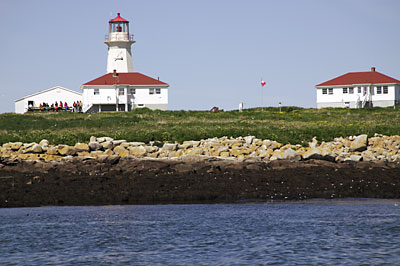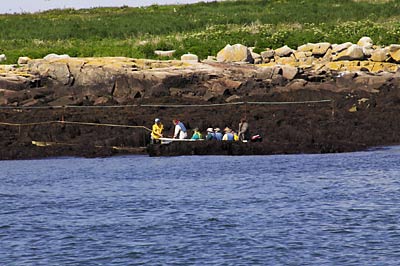 Here's
the island. To the left of the lighthouse you can see a group of people.
That's a Canadian tour group on the "patio". Since only 15 visitors can be
on the island at any one time, we have to wait until they leave. Their boat,
similar to ours, is moored a short distance from us and they are shuttled to
shore the same as us - in a little 16' rowboat with a 20 hp engine on it.
After the Canadian captain picks up a boat load of his people and leaves the
island, our captain heads to shore with a load from our group. Now the
relationship gets interesting. Since the Canadian has to make a second trip
to pick up more of his people, rather than go back to shore empty, he comes
to our boat and loads a few more from our group and takes them to shore. At
the same time, our Captain, rather than come back to our boat empty, loads a
few of the Canadians and takes them to their boat before getting the last of
us to shore. Can you follow all that? Now here's a question for you legal
types - I'm in a vessel
(the rowboat) registered in Canada, owned by a Canadian and piloted by
someone who I did not pay for the trip. I'm in US territorial waters,
heading for a piece of land claimed by both Canada and the US. We have an
accident and I'm hurt. Who do I sue and whose laws do I use?
Here's
the island. To the left of the lighthouse you can see a group of people.
That's a Canadian tour group on the "patio". Since only 15 visitors can be
on the island at any one time, we have to wait until they leave. Their boat,
similar to ours, is moored a short distance from us and they are shuttled to
shore the same as us - in a little 16' rowboat with a 20 hp engine on it.
After the Canadian captain picks up a boat load of his people and leaves the
island, our captain heads to shore with a load from our group. Now the
relationship gets interesting. Since the Canadian has to make a second trip
to pick up more of his people, rather than go back to shore empty, he comes
to our boat and loads a few more from our group and takes them to shore. At
the same time, our Captain, rather than come back to our boat empty, loads a
few of the Canadians and takes them to their boat before getting the last of
us to shore. Can you follow all that? Now here's a question for you legal
types - I'm in a vessel
(the rowboat) registered in Canada, owned by a Canadian and piloted by
someone who I did not pay for the trip. I'm in US territorial waters,
heading for a piece of land claimed by both Canada and the US. We have an
accident and I'm hurt. Who do I sue and whose laws do I use?

Here's a boatload of visitors disembarking on the island - note the rope "railings" recently installed after some falls and injuries - in this picture, we are close to absolute low tide. When we left the island, the lower rope was under water and the upper rope was partially under water. In this picture, the boat is in a little "cove" behind some rocks so you can only see part of the hull.
Once inside a blind - the birds are habituated to the blinds - they ignore your presence and carry on life as normal. Some are as close as three feet from you, some are on top of the blinds and some even nest under the blinds.
M.W. Little
Page 11